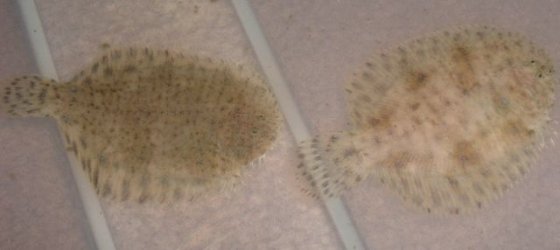jacblades
im not the jedi i should be
Common name/s: freshwater flounder, freshwater sole, hogchoker
Scientific name: Trinectes maculatus (trinectes= "3 swimming" 'referring to the dorsal, ventral and caudal;' maculatus= spotted)
Family: Achiridae (Greek root, Acheir= no hands)
Origin: Estuaries from Massachusetts to Venezuela, most being found around the gulf of Mexico
Maximum size: 6" but much bigger specimens reported in the wild. Usually sold at around one inch
Care: Contrary to their popular name, these guys are brackish fish that can only survive in freshwater for short amounts of time. like most brackish fish, they are born upstream in freshwater and make their way to the ocean throughout their life, hence, the amount of salt (marine salt of course) should be increased as they grow older-eventually full marine conditions are needed.
A sand substrate is imperative as they like to bury themselves, they can cut, crush or trap themselves under gravel. Minimum tank size- 5 gallons (for juvenile flounders), minimum tank size for adults- 29 or 20 long.
They are peaceful bottom dwellers that may prey on very very small slow fish (i lost a bumblebee goby to a larger flounder once.) I keep ghost shrimp with them and they ingore them (but i probably wont be surprised if one ends up being lunch one day).
Feeding: Meaty foods that sink. in the wild, they feed on small crustaceans and worms. They are nocturnal and are more likely to feed at night. a favorite of my flounders is tetra natures delica bloodworm gel. frozen foods, live grindal worms, bloodworms or brine shrimp, clean earthworms for larger specimens. Eventually they can be weaned onto sinking pellets. Once i saw one go for an algae wafer when he was very hungry....or very confused. (algae wafers do contain fish meal but they are not an acceptable food source for flounders)
Breeding: Only in the wild. in the summertime these guys make a trip upstream into freshwaters to spawn. The fry look like normal fry but as they get older, one eye starts to migrate to the right side.
Comments: Colours and patterns can range from fish to fish. (see the picture below.) there are several species in the aquarium trade bearing the name "freshwater flounder." Trinectes maculatus is the most common although they are often mislabeled as Achirus Lineatus. Always ask for the scientific name of the fish you are purchasing. T.maculatus is often confused with Achirus achirus, Achirus lineatus, Achiropsis nattereri and even a less common New Zealand variety known as Rhombosolea retiaria. These are amazing and unique fish but they definately arent for everyone. If given the right conditions (brackish water, sand substrate, peaceful tankmates) and the correct foods, flounders are actually quite hardy and certainly rewarding to watch.
Scientific name: Trinectes maculatus (trinectes= "3 swimming" 'referring to the dorsal, ventral and caudal;' maculatus= spotted)
Family: Achiridae (Greek root, Acheir= no hands)
Origin: Estuaries from Massachusetts to Venezuela, most being found around the gulf of Mexico
Maximum size: 6" but much bigger specimens reported in the wild. Usually sold at around one inch
Care: Contrary to their popular name, these guys are brackish fish that can only survive in freshwater for short amounts of time. like most brackish fish, they are born upstream in freshwater and make their way to the ocean throughout their life, hence, the amount of salt (marine salt of course) should be increased as they grow older-eventually full marine conditions are needed.
A sand substrate is imperative as they like to bury themselves, they can cut, crush or trap themselves under gravel. Minimum tank size- 5 gallons (for juvenile flounders), minimum tank size for adults- 29 or 20 long.
They are peaceful bottom dwellers that may prey on very very small slow fish (i lost a bumblebee goby to a larger flounder once.) I keep ghost shrimp with them and they ingore them (but i probably wont be surprised if one ends up being lunch one day).
Feeding: Meaty foods that sink. in the wild, they feed on small crustaceans and worms. They are nocturnal and are more likely to feed at night. a favorite of my flounders is tetra natures delica bloodworm gel. frozen foods, live grindal worms, bloodworms or brine shrimp, clean earthworms for larger specimens. Eventually they can be weaned onto sinking pellets. Once i saw one go for an algae wafer when he was very hungry....or very confused. (algae wafers do contain fish meal but they are not an acceptable food source for flounders)
Breeding: Only in the wild. in the summertime these guys make a trip upstream into freshwaters to spawn. The fry look like normal fry but as they get older, one eye starts to migrate to the right side.
Comments: Colours and patterns can range from fish to fish. (see the picture below.) there are several species in the aquarium trade bearing the name "freshwater flounder." Trinectes maculatus is the most common although they are often mislabeled as Achirus Lineatus. Always ask for the scientific name of the fish you are purchasing. T.maculatus is often confused with Achirus achirus, Achirus lineatus, Achiropsis nattereri and even a less common New Zealand variety known as Rhombosolea retiaria. These are amazing and unique fish but they definately arent for everyone. If given the right conditions (brackish water, sand substrate, peaceful tankmates) and the correct foods, flounders are actually quite hardy and certainly rewarding to watch.

